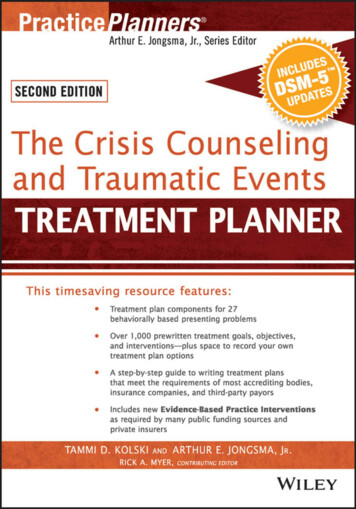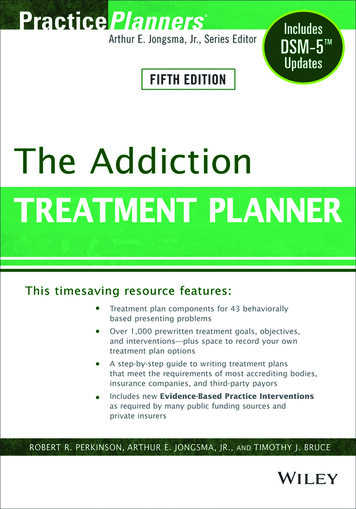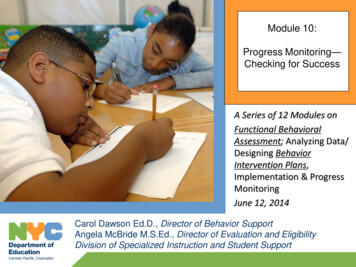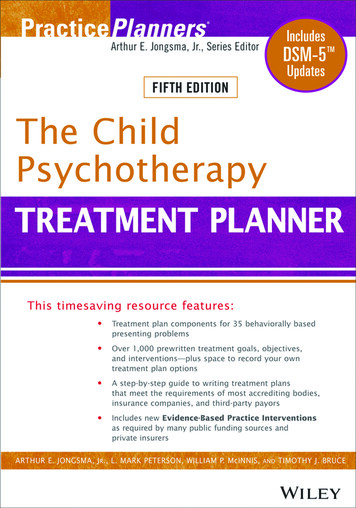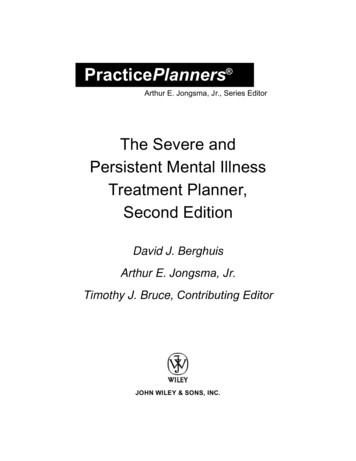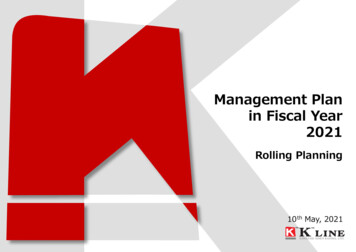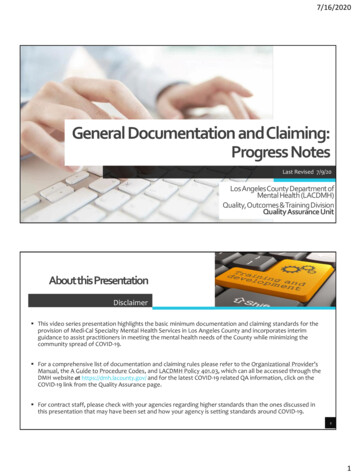
Transcription
7/16/2020General Documentation and Claiming:Progress NotesLast Revised partmentofof Mental Health (LACDMH)Quality, Outcomes & Training DivisionQuality Assurance UnitAbout this PresentationDisclaimer This video series presentation highlights the basic minimum documentation and claiming standards for theprovision of Medi-Cal Specialty Mental Health Services in Los Angeles County and incorporates interimguidance to assist practitioners in meeting the mental health needs of the County while minimizing thecommunity spread of COVID-19. For a comprehensive list of documentation and claiming rules please refer to the Organizational Provider’sManual, the A Guide to Procedure Codes, and LACDMH Policy 401.03, which can all be accessed through theDMH website at https://dmh.lacounty.gov/ and for the latest COVID-19 related QA information, click on theCOVID-19 link from the Quality Assurance page. For contract staff, please check with your agencies regarding higher standards than the ones discussed inthis presentation that may have been set and how your agency is setting standards around COVID-19.21
7/16/2020Purpose of Progress Notes Documents what is going on with the client Identifies what you and any other participating staff did (i.e. what intervention was provided) Identifies progress and response to treatment Documents interventions for reimbursement Provides the basis for benefits establishment Establishes an audit trail Reduces risk and liability3Progress Notes -Required Elements Date of service and date written (ifdifferent than date of service) Procedure code (e.g. TCM – T1017, Rehab –H2015) Duration of service (Face-to-Face Time Other Time) For group, the total number of clientspresent or represented Location of interventions Relevant aspects of client care Relevant clinical decisions Interventions applied Client’s response to interventions Referrals to community resources andother agencies (when appropriate) Follow-up care and discharge summary(if applicable) Signature of the person providing theservice (or electronic equivalent);discipline/job title, relevant identificationnumber (if applicable) and datedocumented42
7/16/2020Progress Notes – Documentation Rules Progress Notes must: Be completed prior to the end of the next scheduled workday If next scheduled workday exceeds 5 calendar days then must be completed before the end of the day on the date ofservice. Be done prior to submission of a claim One note per service contact Don’t combine service components/types of services in the same progress note (e.g. TCM and Rehab services provided duringthe same meeting with the client should be documented in separate notes) Exceptions: Plan Development may be combined into a single progress note with another service Record Review can be conducted in conjunction with another service (e.g. prep for a session that day) and would be claimed asOther Time under the code for that service (See QA Bulletin 17-19) For Targeted Case Management, a single service contact may include multiple service activities (e.g. telephone calls) performedwithin the same calendar day and intended to accomplish the same specific objectiveNote: A Progress Note must be written to document ALL activities – even those that are not billable.5Progress NotesQuestions to Guide Documenting in the Progress NotePurpose of the Service: What was the goal or reason for service? The service should be tied to a treatment plan objective in the CTP. The service should address the client’s functional impairment and qualifying diagnosis.EXAMPLE: met with client in client’s home for the purpose of addressing use of self regulation techniques to manage symptoms of PTSD and improvefunctioning and to provide client with additional support and interventions to assist in meeting her mental health objective.Progress of Client: What are the client’s current symptoms and functional impairments? Use direct quotes from the client. Document objective observations of client behaviors and impairments. What did you see?EXAMPLE: Client reports re-experiencing her childhood sexual abuse trauma daily this week after seeing her abuser at the store. Client shared that she hasbeen experiencing intrusive images most of the day after seeing her abuser. Client reported that she’s not been sleeping well and feeling very irritable.Client stated, “Seeing him again, brought up so much stuff. The images I see in my head make me feel like it’s happening all over again.” Client reportedthat she had 5 months and 10 days sober until a few days ago. She stated that alcohol seemed to be the only thing that helped to stop the images fromcoming at least for a little while. She reports she has been drinking a fifth of vodka daily for the past 2 days. Client observed to be slightly disheveled and 2empty bottles of vodka were laying around the room. If significant changes in the client’s condition are presented, ensure the information is documented in the AssessmentAddendum and updates to the Client Treatment Plan are completed before providing related treatment services.63
7/16/2020Progress NotesQuestions to Guide Documenting in the Progress NoteActual Intervention: What did you do to support the client in working towards the identified goal or reason for service? Illustrate what you did on behalf of the client’s mental health goals. Describe the intervention in concrete active language.EXAMPLE: Acknowledged client’s situation, reviewed client’s treatment goals, and with the use of Motivational Interviewing asked if client would liketo change how she manages her stress. Reviewed safety plan and who client is able to contact for support. Reviewed coping skills toolbox andencouraged client to select coping skills she can use this week instead of drinking. Educated client on the impact of stress to the body and assistedclient in identifying how stress affects her physical response and a sense of re-experiencing the traumatic experience. Reviewed with client the deepbreathing techniques taught to her in previous sessions and engaged client to practice the techniques. Educated client on mindfulness and taught clientgrounding exercises as an additional technique to manage her PTSD symptoms.Client Response: How did the client respond to the intervention? Use direct quotes from the client. Document objective observations of client’s response(s) to the intervention.EXAMPLE: Client reported that she wants to be able to manage her emotions better and not let her past get to her. She reviewed and updated safetyplan to include more contact information of support system. She reviewed her coping skills tool box and identified deep breathing has usually beenhelpful. Client participated in the deep breathing techniques, agreed to learn about mindfulness and asked questions for clarification, and engaged ingrounding exercises. Client reported, “I feel more relaxed and present after this session and am grateful to feel like I can have more control over this. Iknow I have people supporting me and I just need to reach out.” Client appeared more relaxed and started cleaning out the alcohol bottles from herhome.7Progress NotesQuestions to Guide Documenting in the Progress NotePlan: What are the next steps in treatment? Document if there was homework assigned and/or what the client plans to do to address treatment goals. Document if there was an update/adjustment in the treatment plan and/or what practitioner will do if applicable. Document next session schedule.EXAMPLE: Client plans to practice deep breathing techniques at least twice daily and more if she is triggered. Client plans to incorporate groundingtechniques during deep breathing. Client agreed to attend her therapy session tomorrow to address the thoughts she has when she gets the triggeringimages and discuss with therapist if more frequent sessions are needed for now. She also agreed to reach out to her AA sponsor today since the urge todrink is stronger. Next session schedule for xx/xx/xx.84
7/16/2020Progress NotesGeneral Tips: Be accurate: Specify where information came from. e.g. “client reports,” “significant support person informed,” “written reports from DCFSstated,” etc. Be objective: Do not use negative, biased, and prejudicial language. Base things on facts, not interpretation. Be concise: Document all necessary information to support treatment and avoid unnecessary details. Include adequate detail: Do not exclude information critical to explaining treatment decisions/interventions orsignificant information regarding the client.9Progress NotesGeneral Tips: Individualize notes: Be specific to the client and to the session. Do not cut and paste. Be specific: Do not use jargon or vague terms. Be reader friendly: In keeping the necessary terminology, also document your objective observations in a simpleand understandable manner. Thus, when others review the chart, a clear picture of the client will be presentedand treatment decisions will be supported. e.g. Client behaved impulsively as evidenced by blurting out remarks during group session. Reviewed grouprule (i.e. raise hand when ready to speak) and redirected client 2x during 90 minute group session. Respect confidentiality: Do not name or quote anyone who is not essential to the record.105
7/16/2020Procedure Code Selection in the Progress NoteWhen deciding whether an activity or service provided is reimbursable/claimable, hereare a few important questions to ask yourself: What was the specific purpose of the activity/service provided? What Service Component and Type of Service were provided? Does the service match an Objective on the Client Treatment Plan (CTP) that relatesback to the Assessment? How will this activity directly improve or preserve the client’sfunctioning or prevent deterioration of their mental health condition? Is there an apparent Medi-Cal Lockout* rule that applies here?*Medi-Cal Lockouts: Specific situations when reimbursement for specific Medi-Cal services is not available.11Procedure Code Selection in the Progress Note - ExampleActivity/Service:Case Manager (CM) spoke with a coordinator at the VA by phone and referred client to a Veteran’sSupport Group.1. What was the specific purpose of the activity/service provided? To link client to services (a support group)2. What Service Component and Type of Service were provided? Referral and Related Activities under Targeted Case Management (TCM)3. Does the service match an objective on the Client Treatment Plan (CTP)? Yes, if client is a veteran and diagnosed with PTSD and has a related CTP objective4. How will this activity improve/prevent deterioration of client’s mental health condition orpreserve their functioning? It will assist with the treatment of the PTSD5. Is there an apparent Medi-Cal Lockout that applies here? No6. What procedure code should be selected? TCM – T1017SC126
7/16/2020Documentation & Procedure Code Selection for Group and Family ServicesProvided Over the Telephone or Telehealth The use of telephone and telehealth methods of delivery were expanded for groupand family services due to the COVID-19 public health emergency. Add telephone modifier SC or telehealth modifier GT to the following procedure codes,when applicable: Group sessions - 90853, 90847HEHQ, H2015HEHQ, and 90887HEHQ Family sessions - 90847 and 90849 These services should be provided with caution and all clients involved in suchservices must be advised of the privacy risks inherent in conducting group/familysessions over the telephone or through telehealth. For more guidance on Telephone and Telehealth for group/family sessions, please 1 es3-23-2020.pdf13Documentation of Services Provided in a Non-Standard Manner Documentation of services provided in a non-standard manner should include the following within theprogress note: Reason for the nonstandard provision of services (e.g. due to the COVID-19 public health emergency) The method in which it was provided (e.g. telephone or telehealth) Client’s understanding and verbal agreement with the method This guidance applies to any other nonstandard procedures used in response to the COVID-19 crisis. Sample progress note language:This session was provided via [HIPAA-compliant video conferencing or telephone]due to recommendations from public health agencies regarding face-to-face contactrelated to COVID-19. This client agreed to be treated via [telehealth or telephone]and provided verbal consent. The plan for dealing with an emergency during thesession is that the clinician will [call 911 or contact an identified emergency contact],depending on the nature of the situation. The client is aware of this plan.147
7/16/2020SomeExamples ofDeliveringSMHSSomeExamples ofDeliveringSMHSWhat you didTypeServiceProcedure If delivered If deliveredofComponent(s) CodebybyServicetelephone telehealthSession with client forMHSindividual therapy. Reviewedclient’s triggers for depressionand patterns of negative selftalk. Worked on modifyingpatterns of negative self-talkby using statements to ratehis behaviors rather than hisentire self. FTF: 45 OtherTime: 17TherapySpoke with client’s teacherMHSabout behavioral observationsmade in the classroom and theprogress in treatment.Provided teacher withpsychoeducation and modeleda strategy for the teacher touse to assist client inmanaging anxiety symptoms.CollateralWhat you didType90834(based onFTF time)90834GT(based onFTF time)90834:38-52 minH0046SC(there is noface to facetime in aphonesession,thus timeclaimed willbe in othertime)9088790887SC90887GT90834GT:38-52 min15ServiceComponent(s)ProcedureCodeIf deliveredbytelephoneIf deliveredbytelehealthProvided a regularly scheduled CIsession with client. Client wasmore agitated and angry thanusual. Client was yelling,cursing and became physicallyaggressive (i.e. throwingobjects, punching the wall,etc.). Provided emergencyintervention to de-escalateand stabilize the client. Furtherassessed for dangerousnessand suicidality.AssessmentH2011H2011SCH2011GTClient is currently hospitalizedfor being a danger to himself.Completed housingapplication and submitted tothe housing authority.Referral &RelatedActivitiesTCMTherapy00002NA(non-billableto Medi-CalTCM)NAT1017HX (forcontractors)168
Jul 09, 2020 · Note: A Progress Note must be written to document ALL activities –even those that are not billable. Progress Notes Purpose of the Service: What was the goal or reason for service? The service should be tied to a treatment plan objective in the CTP. The service should address the


